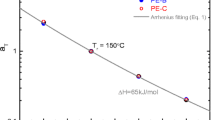Abstract
The transient shear response of a linear molten polymer (linear low-density polyethylene) in the nonlinear domain was studied using a true shear (sliding plate) rheometer with different gap spacings to detect slip effects. It was found that nonlinear viscoelasticity is further complicated by wall slip phenomena. Experimental evidence suggested that static slip models coupled with Wagner’s constitutive equation cannot adequately describe the experimental data at large and fast shear deformations. A new dynamic slip model involving multiple slip relaxation times is proposed in this paper, together with a method to assess the model parameters. Significant improvement in predicting the stress response is demonstrated by several examples of start-up of steady shear and large-amplitude oscillatory tests of a linear low-density polyethylene.











Similar content being viewed by others
References
Archer LA (2005) Wall slip: measurement and modeling issues. In: Hatzikiriakos SG, Migler KB (eds) Polymer processing instabilities. Marcel Dekker, New York
Baumgaertel M, Winter HH (1989) Determination of discrete relaxation and retardation time spectra from dynamic mechanical data. Rheol Acta 28:511–519
Boukany PE, Wang S-Q (2008) Observations of wall slip and shear banding in an entangled DNA solution. Macromolecules 41:2644–2650
Boukany PE, Wang S-Q (2009) Exploring origins of interfacial yielding and wall slip in entangled linear melts during shear or after shear cessation. Macromolecules 42:2222–2228
Boukany PE, Tapadia P, Wang S-Q (2006) Interfacial stick-slip transition in simple shear of entangled melts. J Rheol 50:641–654
Brochard F, de Gennes P-G (1992) Shear-dependent slippage at a polymer/solid interface. Langmuir 8:3033–3037
de Gennes P-G (1979) Scaling concepts in polymer physics. Cornell University Press, Ithaca
Hatzikiriakos SG (1993) A slip model for linear polymers based on adhesive failure. Int Polym Process VIII:135–142
Hatzikiriakos SG (1995) A multimode interfacial constitutive equation for molten polymers. J Rheol 39:61–71
Hatzikiriakos SG, Dealy JM (1991) Wall slip of molten high density polyethylene. I. Sliding plate rheometer studies. J Rheol 35:497–523
Hatzikiriakos SG, Dealy JM (1992) Wall slip of molten high density polyethylene. II. Capillary rheometer studies. J Rheol 36:703–741
Hatzikiriakos SG, Kalogerakis N (1994) A dynamic slip velocity model for molten polymers based on a network kinetic theory. Rheol Acta 33:38–47
Hill DA, Hasegawa T, Denn MM (1990) On the apparent relation between adhesive failure and melt fracture. J Rheol 34:891–918
Kalika DS, Denn MM (1987) Wall slip and extrudate distortion in linear low-density polyethylene. J Rheol 31:815–834
Lau HC, Schowalter WR (1986) A model for adhesive failure of viscoelastic fluids during flow. J Rheol 30:193–206
Mooney M (1931) Explicit formulas for slip and fluidity. J Rheol 2:210
Pearson JRA, Petrie CJS (1968) On melt flow instability of extruded polymers. In: Wetton RE, Whorlow RH (eds) Polymer systems: deformation and flow. Macmillan, London, pp 163–187
Ramamurthy AV (1986) Wall slip in viscous fluids and influence of materials of construction. J Rheol 30:337–357
Soskey PR, Winter HH (1984) Large step strain experiments with parallel-disk rotational rheometers. J Rheol 28:625–645
Stewart CW (1993) Wall slip in the extrusion of linear polyolefins. J Rheol 37:499–513
Wagner MH (1976) Analysis of time-dependent non-linear stress-growth data for shear and elongational flow of a low-density branched polyethylene melt. Rheol Acta 15:136–142
Wagner MH, Rolón-Garrido VH (2008) Verification of branch point withdrawal in elongational flow of pom-pom polystyrene melt. J Rheol 52:1049–1068
Wagner MH, Rolón-Garrido VH, Chai ChK (2005) Exponential shear flow of branched polyethylenes in rotational parallel plate geometry. Rheol Acta 45:164–173
Winter HH (1997) Analysis of dynamic mechanical data: inversion into a relaxation time spectrum and consistency check. J Non-Newton Fluid Mech 68:225–239
Winter HH, Baumgaertel M, Soskey PR (1993) A parsimonious model for viscoelastic liquids and solids. In: Collyer AA (ed) Techniques in rheological measurement. Chapman & Hall, London
Zapas LJ (1966) Viscoelastic behavior under large deformations. J Res Natl Bur Stand 70A:525–532
Author information
Authors and Affiliations
Corresponding author
Rights and permissions
About this article
Cite this article
Kazatchkov, I.B., Hatzikiriakos, S.G. Relaxation effects of slip in shear flow of linear molten polymers. Rheol Acta 49, 267–274 (2010). https://doi.org/10.1007/s00397-009-0416-2
Received:
Accepted:
Published:
Issue Date:
DOI: https://doi.org/10.1007/s00397-009-0416-2




